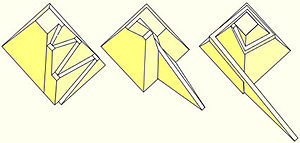
My good friend Jeff Mann, the true Yard Ramp Guy, has asked me to revisit some of my original contributions. And so: my From the Archives series. This week I return to a ramp from my youth, one that taught me—the hard way—to always seek out the best quality.
I broke my first bone when I was eight. My cousin John and I had decided to build a bike ramp in his back yard. His mom was asleep, so we couldn't play inside the house, and we'd already read through his comics a dozen times before.

A Disarming Story For You
We gathered a bunch of cinder blocks and boards from the shed my uncle was building and hauled them out to the top of the big hill behind the house.
I had a brand new Schwinn, and he had one of those heavy black Raleigh bikes from England. The boards were resting on the cinder block at about a 45-degree angle. I went first, on account of John being quite a bit smarter than me. I moved right up against his house to get the fastest start I could. I came at the ramp straight on and made it onto the board I was aiming at, which then promptly broke in half, and I crashed full speed into the cinder blocks.
Somehow I wasn't seriously injured, beyond a couple of scrapes and bruises. We rebuilt the ramp with a much, much lower angle this time. I went first again, again proving John was (and still is) much smarter than I am.
I hit the ramp at full speed again, and this time it held. I must have launched a good seven feet off the ramp, though at the time it felt closer to a hundred. I stuck the landing and shot down the hill faster than I'd ever gone before. I would have made it all the way down, too, if it hadn't been for a cinder block that had fallen down the hill when I crashed into the first ramp. My bike flipped over it, and I landed on my arm, breaking it just above the wrist.

Both Arms Now Working Just Fine
John, meanwhile, hadn't bothered to watch me go down. When he saw me ramp, he just had to go himself. He used a different, longer board than I did. As soon as his back wheel hit the end of the board, it flipped up into the air like it were part of a catapult, flew through the air, and somehow managed to land on one end on my injured arm between the wrist and elbow, breaking it a second time before bouncing farther down the hill.
John had lost control of his bike after the failed ramp attempt. It came tumbling down the hill in loose pursuit of the board and landed right on top of me, which didn't feel too good. John was chasing his bike, but when it came to a sudden stop, he didn't, and he fell right on the bike, which forced all of that weight onto—yes—my injured arm again between the shoulder and elbow, breaking it a third time.
To add insult to injury, I got grounded for twice as long as John. There is one continuing advantage to the whole escapade, though: John always buys the beer when we go fishing. I guess he still feels a little bad.
The Yard Ramp Guy®: Ramping Up For The 2019 Holidays
This week, my friend The Yard Ramp Guy has apparently become a big fan of the IRS. I’d be concerned, though his perspective makes perfect sense.
Audit his words HERE.

 the TV. I can't say as I'm a huge fan now, but I can definitely see the appeal. (Except for robots. We've already lost enough jobs to them; manufacturing lines hardly even need people anymore.)
the TV. I can't say as I'm a huge fan now, but I can definitely see the appeal. (Except for robots. We've already lost enough jobs to them; manufacturing lines hardly even need people anymore.) I don't know how much power teleporters use, but I feel like it can't be cheap to run one. Plus, the teleporters come out in those nice, carpeted rooms. They can't possibly load all their stuff from there. There'd be marks all over the carpet.
I don't know how much power teleporters use, but I feel like it can't be cheap to run one. Plus, the teleporters come out in those nice, carpeted rooms. They can't possibly load all their stuff from there. There'd be marks all over the carpet.

 The ancient Egyptians obviously didn't have the technology for moving heavy loads that we did. All they had were a few primitive cranes, some basic levers and rollers, and, of course, ramps.
The ancient Egyptians obviously didn't have the technology for moving heavy loads that we did. All they had were a few primitive cranes, some basic levers and rollers, and, of course, ramps. It seems more likely that they instead either zigzagged the ramp up one side or spiraled it around the pyramid, using uncompleted segments as the ramp. This would have allowed them to construct the vast majority of the pyramid easily, though the top third of the structure would have needed to be moved up, using levers. Since it's so much narrower at the top, though, that top third makes up less than five percent of the total weight of the pyramid. That's working smart.
It seems more likely that they instead either zigzagged the ramp up one side or spiraled it around the pyramid, using uncompleted segments as the ramp. This would have allowed them to construct the vast majority of the pyramid easily, though the top third of the structure would have needed to be moved up, using levers. Since it's so much narrower at the top, though, that top third makes up less than five percent of the total weight of the pyramid. That's working smart.